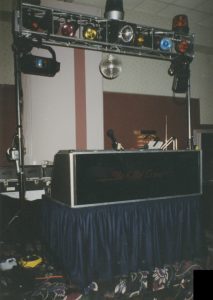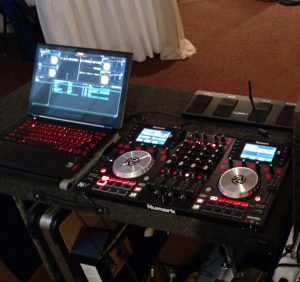By Stu Chisholm, “The Complete DJ”
Things sure have changed since I started my DJ business back in 1979. The technology is just the most obvious, going from vinyl records and tapes, on through CDs and MiniDiscs and, finally to today’s MP3 and other file format playback systems. The bigger change for me, as I reinvent myself and my business, is a shift in scale. My original vision was one of “shock and awe.” I wanted people to know that I was serious, even before I turned my DJ system on. A frequent regular event was a singles club dance held in a combination auditorium/gymnasium. Any DJ playing from a card table looked lost on the big, full-sized theatrical stage! I built my system to dominate.


Of course, when I started out, I was also in my 20s. It was no big deal to haul hundreds of pounds of gear, set it all up over the course of two hours (yes, two hours!), spin the party for anywhere between six and ten hours, and then tear it all down, pack it all up and bring it all back at the end of the night, usually with the help of at least one assistant.
Changes in attitudes…
But technology has not only changed our gear, but our ways of thinking. DJs are beginning to realize that their clients, especially wedding couples, spend massive amounts of money on their décor. They might not want to see a ton of gear, even if it’s nicely cased, looking like something that is air dropped by the military to an Antarctic research station, or maybe touring with Metallica. Additionally, the space reserved for entertainment at many venues is often an afterthought. Tighter spaces rule out the massive presentations of the past. Lastly, after more than 30 years working as a DJ, the physical realities of the job and the demands on the body are not as easily met. (A nice way of saying that I’m not as young as I once was!)
Thankfully that same technology that has eliminated the massive, heavy record and CD cases we used to carry in favor of computers and/or tiny hard drives easily carried in a shirt pocket has also dramatically downsized the required gear. This is especially true of lighting. As I detailed here previously, my old eight foot truss with all the color changers, moving heads and hanging lights have now been replaced by a duo of 14 lb. LED marvels by Chauvet. They throw nearly as much light, yet require a paltry fraction of the time to set up (under 5 minutes for both) and are easily hand-carried even by my over 50 self! The time and weight savings are simply phenomenal.
Visual appeal
Having swapped my old, heavy DJ cube console for a sleek computer and controller, and keeping the above size and visual concerns in mind, I went on a search to find the perfect case to make my nice new gear into a true console. Hours of fruitless searches online sent me calling a colleague here in Michigan who does professional audio installations for theaters, nightclubs and houses of worship. He understood my misgivings right away and suggested I contact a furniture builder who doesn’t “think audio.” This sent me on an even longer search, and while there were some fantastic, talented builders with some great out-of-the-box ideas, not one of them really understood the essential part of the plan: the need for PORTABILITY. I had almost resigned myself to once again having to lug around some massively heavy rig when inspiration suddenly struck.
Back in the late ‘80s and all through the ‘90s, Jeff Rounds, who ran Night And Day Productions, was a trusted friend and colleague. We often traded work and referred each other. Jeff also has an engineering background and would build his own road cases, stands, etc., always with results looking indistinguishable from stuff available in stores. Having retired from the DJ business some years ago, he’s since gone into home remodeling and building. Sometimes he shares e-mails showing off his latest work. It was one of those e-mails that gave me the “aha!” moment. Here is a guy who “gets it.”
The main two goals of building any console are to protect our gear from damage in-transit, and have it pre-assembled/wired to reduce set-up time. For my purposes, I added one more requirement: to look like it belongs at a formal event, yet not look out-of-place at the company picnic or bar. After consulting with Jeff and coming up with a few design options, I decided on a rosewood laminate, which compliments the slightly sinister black and red look of the new gear. Jeff and I met and he is now at work. I can hardly wait!


Once completed, this will allow my system to have more capability than I’ve ever had before, yet occupy a footprint of less than 3 square feet, or roughly the size of the aforementioned card table, not including lights and speaker stands. Down the road, I also have plans to put my speakers on a diet, yet deliver even more dBs if required.
So what happens if the tide turns and I’m once again playing on the big stage? My thought is that I need to focus less on gear and more on personality and performance. Neil Patrick Harris seems to fill up a stage pretty well all by himself! The diminutive Kristin Chenoweth is a giant on Broadway. It’s more about the talent and performance that you put on the stage than it is about what equipment fills it. In short, I plan on doing much more than I ever have, with much less gear and bulk. With all of the work I’m doing on my equipment, there will be even more when it comes to my own performance. But that’s a topic for a future column.
I hope you’ll follow my journey as I reinvent my business from the ground up. You’re also welcome to send me your suggestions, comments or criticisms to: [email protected]. Note that anything submitted may be mentioned here or in my other columns, so be sure to let me know if you’d like your name omitted. Until next time, thanks for reading and safe spinnin’!
